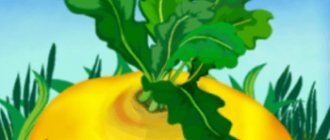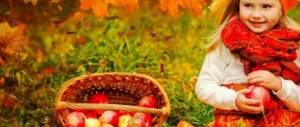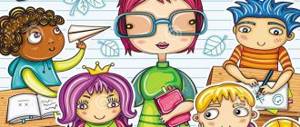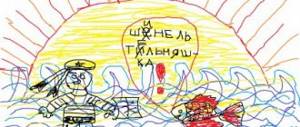CABBAGE
The garden is empty if there is no... That's right, cabbage. This vegetable has been known to people since ancient times. Ancient people ate wild cabbage leaves. Cabbage began to be grown about 7 thousand years ago, in Spain. From there this culture spread to other countries. In Rus', cabbage began to be cultivated in the 11th century. This vegetable is one of the most popular among people. “Why have a garden if you don’t plant cabbage,” people say. Why do people value cabbage so much? Because the most delicious, very tasty cabbage leaf. (A. Krylov)
Cabbage is not only tasty, but also healthy. The famous Greek mathematician Pythagoras wrote: “Cabbage is a vegetable that maintains vigor and a cheerful, calm mood.” Cabbage contains many vitamins, proteins, sugars and various mineral salts. Most of the nutrients are in the stalk. On a hot day and on a cool day, Cabbage wants to be elegant. She stands on a large leg and holds all her clothes in her arms. (G. Grinev) The most common variety of cabbage is white cabbage. This is a biennial plant. In the northern regions, in the spring, when it is warm outside, seedlings are planted in the ground. In the first year of cabbage, a shortened stem grows, it is called a stump; wide leaves form around it - “a hundred clothes” - collected into a head of cabbage. A head of cabbage is not a cabbage fruit; it does not contain seeds. To get cabbage seeds, in the fall you pull out the cabbage stalk with its roots. In winter it is stored in a cool place, and in spring it is planted in the ground. Tall stems grow from the stalk, and clusters of yellow flowers appear on them. In autumn, the flowers produce fruits - pods with small round seeds. RIDDLE One-legged Panteley dressed warmly. I pulled on a hundred clothes, but didn’t button a single one. He was in a hurry to go to the fair, but his pocket was empty. The kids all call Panteley... (Cabbage) PROVERBS AND SAYINGS Without cabbage, cabbage soup is not thick. The hare is a coward, and he even hunts for cabbage. Don't meddle with the cabbage until they let you in
Fairy tales - compositions, children's creativity
Section: Methods and technologies
Publication date: 2012-07-11 | | Author: Olga Bogdanova
Matryoshka's tales.
Speech development is of fundamental importance in the development of a preschool child, which is aimed at practical language acquisition and speech awareness. In preschool age, its practical use is improved. The child’s activity in relation to language is expressed in word formation, word creation, and writing. Older preschoolers come up with various stories and fairy tales with interest and imagination.
How to help a child write if he has not yet learned to write, or writes in block letters, but very slowly. The desire to write down your thoughts may leave the child due to the difficulties of preserving what he has invented.
In this situation, parents or educators will help. I offer you options for work done by parents together with their children.
Tales about vegetables and fruits.
Author Katya Peshina – 5 years old.
Author Makar Baykov – 6 years old.
“Vegetables in the garden” In the summer we planted vegetables in the garden: beets, carrots, onions, cabbage and pumpkin. The sun was warm, the rain was pouring and the vegetables were growing quickly in the garden bed. Birds collected harmful beetles, cats caught digger moles. The vegetables lived well and amicably in the garden. The vegetables grew and told each other fairy tales, sang songs, the only thing that upset them was that they couldn’t reach each other and play because they grew in different beds.
Summer has come to an end and autumn has arrived. It became cold and rainy in the garden, all the fairy tales were told, all the riddles were asked - the vegetables became sad. But the time has come to harvest. People dug and collected vegetables, brought them into the house, peeled, cut and cooked delicious vegetable soup from them. The vegetables were so happy when they met all together in one pan! They began to run after each other, catch up, catch and run away again.
The tasty and healthy vegetable soup was swirling merrily on the stove.
End
Author Anya Kern 6 years old.
“A fabulous journey of vegetables”
Once upon a time there were cucumbers, tomatoes and carrots. One day a tomato says: “My grandfather told me that somewhere far away, beyond the seas and oceans, there live creatures similar to us.” “Oh, how interesting!” - exclaimed the carrot. “Let’s go on a trip and get to know them at the same time,” suggested the cucumber. So they began to get ready for the long journey. Two days passed, the friends put together a boat, inflated the mattress, pulled the sail and set off.
They sailed for a day, then another, suddenly it began to rain heavily, the wind blew, and a storm began. The wind tore the sail and the boat almost capsized. When the sea calmed down, they looked around, and there was nothing around except water. The cucumber, tomato and carrot got scared and started screaming and waving their arms. Suddenly someone’s face appeared from the water. It was the dolphin Styopa who swam past and heard screams. Friends began vying with each other to say that they had sailed to look for creatures similar to themselves. And Styopa answers them: “Yes, I know, people like you live here not far away on the island. I will accompany you!
A cucumber, a tomato and a carrot jumped onto the back of a dolphin and swam to the island. Styopa quickly brought them to the sandy shore. They went ashore, and the carrot screamed: “Look, look - what an orange tomato and a yellow cucumber!” The dolphin laughed: “Yes, these are oranges and bananas. Come on, I’ll introduce you to them!” This is how cucumber, carrot, tomato, banana and orange became friends! They began to visit each other, and they didn’t forget about Styopa!
The fairy tale is over.
prodetsad.spb.ru
CARROT
I love carrots! Here it is still in lumps of clay. It lies elegant and juicy - full of vitamins! I even taught the puppy to chew carrots to grow. It is simply necessary for a snowman. (V. Sabirov) People began to grow carrots a long time ago - about 4 thousand years ago. This plant does not require special care - throw a seed into the ground and wait for the harvest. If the soil is not very fertile, this is not a problem - carrots grow well even on sandy soils. Carrots tolerate drought and slight cold equally easily. Carrots love sunbathing, so they are sown in an open, not shaded place. Since the 14th century, carrots began to be grown in Rus'. The peasants came up with many proverbs and sayings related to carrots. “Lying on the floors, you won’t see the carrots!”, “Sow the carrots on time, it will be good.” The most valuable part of the carrots that we eat is the root vegetable. It is formed in the first year of carrot life. The root crop is completely in the ground, only its upper part sticks out, and above it is a green tail of leaves similar to dill leaves. Why are carrots so beneficial? Carrot roots contain a huge amount of beta-carotene, which is converted into vitamin A in our body. It is also called growth vitamin - it is very useful for children. Carrot seeds also bring benefits to humans. They are used to make a medicine used to treat heart disease. And in Rus', for a long time, pain in the liver and nasopharynx was relieved with carrot juice.
Carrot roots come in different shapes: cone or cylinder. And their weight can reach half a kilogram! By the way, by the shape of a carrot you can determine where it grew. If the root crop is long and sharp, the conditions for its growth were not the best - dense and heavy soil, little water. If the carrot is short and thick, it means that it has been “corroded” on fertile soil, with abundant and frequent watering. Carrots are not necessarily orange in color. There are varieties of carrots that are yellow, white, and even dark purple. RIDDLES From the hole I pull the red fox by the bushy withers. But not a cunning cheat, but a crunchy one... (Carrot) * * * I grew for many days, becoming redder and sweeter. I became crispy. And I have a green tuft, guys, so that everyone can pull it and pull it out of the garden. (Carrot)
A fairy tale about vegetables for children
Contents
A fairy tale about vegetables for children is not just entertainment. Thanks to it, the child gets acquainted with this or that product, finds out what color it is, what shape it has. An interesting story about the benefits of vegetables may interest a child. He will love to eat them, and this is very important for his body.
A fairy tale about vegetables for preschoolers should not only have fascinating content, but also be presented in simple and accessible language.
What does a fairy tale teach?
A fairy tale is not just entertainment for a child. She is able to teach, educate, solve many problems, and also calm. Thanks to a fairy tale, you can explain to your baby or toddler many things that are difficult to understand with a normal explanation. There are, for example, children's fairy tales about vegetables and fruits that will help you find out the names of certain products, as well as recognize their beneficial properties.
The therapeutic effect of fairy tales
Incredibly, fairy tales have a therapeutic effect. A fairy tale about vegetables for children can be no worse than one where the main characters are people. This way, the child can quickly get acquainted and “make friends” with new vegetables. If he refuses to eat certain foods, then an interesting fairy tale about vegetables will help change his attitude towards them. Reading or listening to fairy tales, you are involuntarily transported to the world of magic and fantasy, dreams and daydreams. In this amazing world, anything can happen. Animals and birds can talk, houses can be made of candy, people can travel through time, fly, etc. The world of fairy tales is always kind and beautiful. That's why not only children, but also adults like them so much.
Merry vegetable garden
This is a short story about vegetables. One day a puppy was walking through the garden and met its inhabitants. But I just didn’t know what their name was. We need to help the puppy learn about the inhabitants of the wonderful garden.
First the dog saw a green and pimply creature. Who is it? So this is a cucumber, a real brave daredevil.
Then he met a handsome red man. It was ripe, juicy and a little chubby. It's Signor Tomato!
And here is a business lady, she is dressed in a hundred fur coats. And in the summer she is not the least bit hot. This is cabbage that just can't get warm.
Who is it that exposed his side to the sun? He didn't tan, but just turned a little white. Yes, this is a couch potato.
He walked further and saw colorful bushes. These were sweet peppers of different colors: red, orange, yellow and green.
He also saw a girl whose braid was always on the street, and she herself was sitting in prison. Who is this? Of course, carrots. Now the puppy knows who lives in the cheerful garden. It is inhabited by wonderful people.
Tale about vegetables (funny)
Grandfather planted a turnip. And I expected her to grow very, very big. It's time to. Grandfather began to dig turnips. He pulls and pulls... And then he hears that the vegetable is talking to him.
- Grandpa, what kind of turnip am I to you, I’m a red carrot with green curly hair!
“These are miracles,” says the grandfather, “but where did I plant the turnip?” I do not remember. Get into my basket, you’ll need it for soup, but in the meantime, we’ll look for it together. He walks further through the garden. Pulls and pulls...
“Oh, be careful with me, I’m not a turnip, but a beet,” answered the burgundy lady in a businesslike manner.
“How can that be,” says the grandfather, “I got it mixed up again.” I'm an old fool. Well, come with me, you’ll need some borscht. He moves on.
“You’re probably a turnip,” the grandfather turned to another vegetable.
- Who am I? No, what are you? I'm a potato.
“Here you go,” muttered grandfather, “oh, old age is not a joy.” He's blind and has problems with his memory. How can I find a turnip?
“Here I am,” exclaimed the turnip, “how long can I wait for all of you?” I'm sitting here, bored, alone.
“Finally,” the grandfather rejoiced. I wanted to pull it out, but a really big, big turnip was born. Probably we should call our grandmother, granddaughter and others. How did grandfather pull the turnip? Well, that's another story...
Vegetable dispute
This is an autumn tale about vegetables. Once upon a time there lived an old man and an old woman. Grandfather watched TV in the evenings, and grandmother knitted socks for him. They became bored with living like this. We decided to get a vegetable garden. They spent days fiddling with it. They really liked that time flew by quickly and it was not boring at all. It's time to sow the seeds. The grandfather did not entrust such a serious matter to the grandmother. I went to the market myself and bought everything. I decided not to call grandma, but to sow the seeds myself. But he stumbled, and all the seeds scattered throughout the garden.
Grandfather came home gloomy. And he says: “Now how can we find out where the carrots are and where the beets are!” “Don’t worry, grandfather,” said the grandmother, “the time will come, we’ll figure it out ourselves.”
Autumn has come, it's time to harvest. An old man and an old woman were watching, and the vegetables were all so beautiful and ripe. But they argue with each other about which of them is better and more useful.
– I am a tomato, I make a delicious tomato. I'm the best.
- And I’m the most useful of all. I am an onion, I save everyone from illness.
- But no. I'm also rich in vitamins. I am a sweet and very tasty pumpkin, and I am also very bright and beautiful.
“You’re not the only one who shines with beauty.” I am a red carrot, I am a beautiful girl. Healthy and tasty, everyone really likes it.
The vegetables argued for a long time until the grandfather and grandmother said: “You are all in charge, important and useful. We will gather you all, we will not leave anyone in the garden. Some will go into porridge, some into soup, and many of you will eat it raw and very tasty. The vegetables were delighted, laughed and clapped.”
A therapeutic tale about healthy vegetables. Part one
This story about vegetables is perfect for those children who have problems with food. Approximate age: from 3.5 years. Many children enjoy conversations about tasty and healthy food, as well as junk food. The main thing is that they are interesting. If you are telling a therapeutic story, you should not use your child's name for the main character.
So, a therapeutic tale about vegetables could be next. Katya, as usual, was visiting her grandmother during the summer holidays. She really liked this village. The bright and warm sun always lifted my spirits, and I could always swim to my heart's content in the clean river. Only Katya was very often capricious and did not obey her grandmother. She did not want to eat cooked vegetables and fruits. The girl refused to eat them and said: “I don’t want this, I won’t do this. I don’t eat this green one, but take away this red one.” And everything like that. Of course, this greatly upset the grandmother, because she tried so hard for her beloved granddaughter. But Katenka couldn’t help herself.
A therapeutic tale about healthy vegetables. Part two
One day the girl went outside and heard someone talking in the garden. She came closer to the beds and was very surprised. The vegetables were arguing among themselves.
“I am more important than everyone else in the world,” said the potato, “I am able to saturate the entire body and give strength for the whole day.” Thanks to my beneficial properties, every child will run, jump, gallop for a long time, and will not get tired at all.
- It’s not true, I’m the most important! - said the beautiful orange carrot. You have no idea how much beta-carotene is in me - a supervitamin. It is good for vision.
“Hmm,” thought Katya, “grandmother probably loves carrots very much, since she still knits and reads without glasses.”
Meanwhile, the vegetables continued to argue:
“Dear friend,” the pumpkin joined the conversation, “don’t think that you’re the only one rich in beta-carotene.” I have plenty of it too. I help people cope with autumn ailments. I also contain vitamin C.
“I also have this vitamin,” the red pepper answered playfully, “I have much more of it than citrus fruits.”
- No, guys, of course, you are important, but I’m still the most important! - said broccoli. – You can eat me not only boiled, fried or stewed, but also raw. I contain the most useful vitamins. And the soup I make is excellent.
- Friends, you are all right, of course, but without me the dishes don’t turn out as tasty. - said the bow in a deep voice, - and I can cure a person of various diseases.
And then the vegetables noticed that someone was watching them, and they immediately stopped their argument, as if they were not talking at all.
- These are miracles! – Katenka said quietly. – And then the grandmother called her granddaughter to eat. Katya realized that she was very hungry and ran to wash her hands. When the girl saw that pumpkin porridge was waiting for her for breakfast, she was very happy. She wanted to try all the vegetables herself and choose which of them was more important and tastier. Katya decided that now she would enjoy eating her grandmother’s salads and porridge and would become beautiful and healthy.
Conclusion
Thus, a fairy tale about vegetables can be educational, therapeutic and developmental. For very young children, choose books with thick pages (preferably made of cardboard) and bright illustrations. The baby, leafing through them, will gradually find out which vegetable is which. Choose fairy tales written in simple and accessible language. When they are presented in verse, they really attract the attention of children. Make up your own fairy tales. Make up stories, but use another child's name. When your baby grows up, teach him to write fairy tales. Often the fairy tales invented by children are very funny and interesting.
fb.ru
ONION
The earth around is still black and not warmed by the sun, But onions are sprouting in the garden - a cheerful messenger of summer. When, trembling from the dampness, he pulls the arrows up, the garden bed will look like a green hedgehog. (V. Sabirov) The most common type of onion is onion. It is grown in almost all countries of the world. Since ancient times, people have eaten wild onions. And about 6 thousand years ago in India and China they began to grow it as a garden plant. Among the Egyptians, onions were universally loved. The ancient Greeks revered the onion; they perceived the onion as a symbol of the structure of the Universe. At festivities in honor of the god Pan, the protector of forests and fields, his sculptural images were showered with onions. On festival days, the Greeks tried to bring the largest onion to the temple. The ancient Romans believed that onions energized a person and protected against disease. In the 12th century, onions appeared in Rus'. On September 20, peasants celebrated bow day. They took the onions to the market to sell. Whoever collected a lot of onions and sold them quickly has a good income. Onion Day is a sad holiday for two reasons. The first is that it coincided with the end of Indian summer, with warm days left behind. Secondly, girls and women had to shed a lot of tears on this day while processing onions. The bulb consists of several layers of inner leaves. This is where the plant stores nutrients. And there are a lot of them in onions - both vitamins and mineral salts. Scientists have found that in terms of usefulness, onions are in third place among vegetables, second only to beets and parsley root. The essential oils it contains give the onion its pungency. They cause irritation to the mucous membrane of the eye, which is why we cry when we cut onions.
Onions contain substances that kill harmful bacteria. In order to avoid getting colds, you need to eat onions. You can also grow onions at home. Just put the onion in a jar of water. In a few days, the onion will take root and green leaves will stretch up. There are bitter varieties of onions, and there are sweet ones. Different varieties of onions have different bulb colors: red, purple, yellow, white, pink. Nowadays, not only onions are grown. Dishes to which leeks, shallots, spring onions, and chives are added are very tasty and healthy. PROVERBS AND SAYINGS Hurry up to harvest the onion harvest. Onion - from seven ailments.
- To the begining
- Back
- 1
- Forward
- In the end
Tale about vegetables | Nochdobra.com
Masha had a lot of vegetables growing in her garden. Cabbage, beets, carrots, potatoes, onions, tomatoes, cucumbers, greens stretched towards the sun and waited for moisture. Their roots absorbed rain and water that Masha or her grandmother watered the vegetables. Every year, the vegetables at the girl’s dacha grew friendly. The girl knew how to eavesdrop on their conversations. But this year, to her surprise, Masha heard carrots and cabbage quarreling, onions and potatoes calling each other names, and cucumbers generally ignoring all the plants in the garden. The fairy tale about vegetables tells how Masha reconciled everyone in the garden.
A fairy tale about vegetables for children
Masha knew from childhood that vegetables are very healthy for children and adults. They contain many vitamins. Vegetables help digestion, body development, improve thinking and blood circulation. Every summer, the plants in her beds grew from small sprouts to juicy and bright, fragrant and tasty. And everyone knew about their important mission - to feed people and give them their beneficial substances. But the fairy tale about vegetables ended the day Masha heard quarrels in the garden.
- You stupid potato drinks all the water! And I have absolutely nothing left! - parsley cursed at the potatoes. - Who needs you, little one? - the potato bush answered rudely. - I will feed the whole family with myself. I can be fried, boiled, baked, mashed, cut into soup, okroshka, salad. What are you doing? - And not only can you make food out of me, I can also whiten your skin! - Hahaha! Made me laugh! - the potato laughed.
Masha immediately realized that if her plants were not reconciled, all the food would be tasteless. Well, you can’t get a tasty dish from negative food. But how can the inhabitants of the beds be reconciled if in her presence they become silent and pretend that they do not understand human language?
The girl decided to play love songs for the vegetables. I started with popular music - Eldzhey, “Time and Glass” did not make the best impression on the plants.
“Is she making fun of us?” I turned on the music, but we don’t have legs. “We can’t dance,” the beetroot began to complain. - I'm afraid of these songs. My brothers are carried to concerts of such performers and simply thrown onto the stage,” the tomato almost cried. “It’s better to be thrown into singers than to be eaten.” “You’re so tasteless,” the carrot laughed. - Just sit there and keep your head down! — the tomato answered the carrot.
Then Masha brewed a magic potion from hemp and added it to the water. Watered the plants. I expected them to become kinder. But the vegetables continued to quarrel. What can unite the inhabitants of the garden and bring peace? Suddenly Masha heard her grandmother screaming very loudly at her chickens in the neighboring plot, and then started yelling at her grandfather. Previously, kind and peaceful neighbors lived on this summer cottage. And now an evil grandmother has settled in.
“Oh, that’s where my vegetables learned to complain and swear,” the sorceress finally understood everything. That same day, she invited her friends to her dacha, and they built a fence. The guys worked friendly and cheerfully all day, and in the evening they had a feast. With jokes, laughter, love, generosity, support and care.
- You are my best friends! Thank you for helping us build the fence! - Thank you for inviting me to nature! What beautiful beds and delicious vegetables you have here! - Masha’s friends answered.
So the vegetables were able to see that there is a different way to communicate. Polite, friendly, welcoming and beautiful. And the fence forever hid the negative example of communication from scattering. Soon the fairy tale about vegetables appeared again in the beds, because cucumbers and tomatoes, carrots and onions, beets and potatoes were very friendly to each other.
We have created more than 300 cat-free casseroles on the Dobranich website. Pragnemo perevoriti zvichaine vladannya spati u native ritual, spovveneni turboti ta tepla. Would you like to support our project? We will continue to write for you with renewed vigor!
PIDTRIMATE
nochdobra.com







